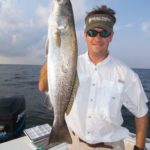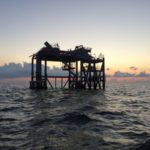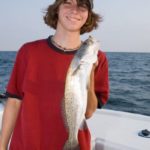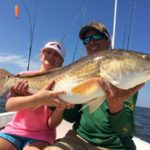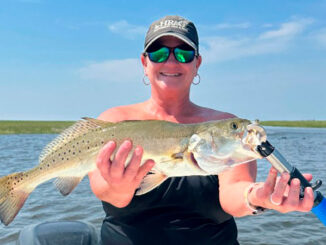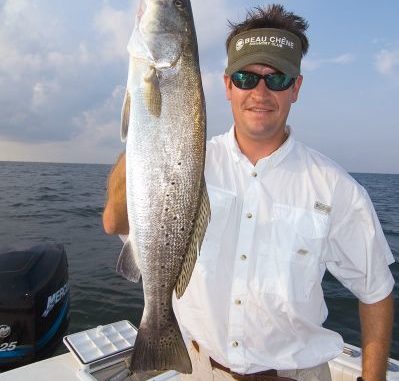
As summer deepens, big specks retreat to the open waters outside the Hopedale marsh. So gas up the boat, pass up the school trout and get ready to haul in yellowmouths.
You’re on your lunch break from work sitting in the A/C, but in the back of your mind you know it would be more enjoyable out in the heat catching speckled trout, like all of the guides are doing.
You try your hardest to play hooky during the week, but you just can’t seem to sneak a day out of the office, so you’re forced to go fishing on the crowded weekend.
You bust your butt to get up early and try to beat everyone, but as luck would have it you arrive to the oil-field structure with about 500 of your closest friends fishing there.
You think you’ll be able to fish around them, but it gets worse when you see them look in the baitwell.
They’re all throwing live shrimp.
Trying to compete with other anglers fishing for the same fish is hard enough, but trying to do it with plastic during the heart of the summer is, well, almost impossible.
Even on the weekdays, Capt. Mark Munson never leaves the dock without live shrimp. It’s just too important when fishing the exterior structures and well heads in the Shell Beach area.
On calm days, of course, his favorite place to run is outside.
“I like being by the open water and outside structures,” Munson said. “It’s the next step up on the fish, as far as quality.”
How far out you should go depends on if you are looking for quality or quantity, he said.
“If you’re limited to the amount that you can get out like most recreational anglers are and you’re concerned with getting some quality fish — 20 big hammers — then you’d better go deep,” Munson said.
The captain said the Central Rig is a fantastic starting point for those looking to get on big trout. You might not land as many trout, but the bites you get could be from some true trophies.
Although places like Bay Eloi and the MRGO rocks have nice trout at times, they are generally great if you’re looking for a meat haul to fill the freezer for your bachelor party.
Munson said no matter how far out you go, however, trying different techniques is an absolute must.
“I fish both a Carolina rig and a sliding cork on a daily basis,” he said. “It just depends on the fish which one I throw. Sometimes they are feeding up top, and sometimes they are feeding on the bottom.
“You can stand next to me with a cork and cast over and over, and I could throw a Carolina rig and slam them.”
When fishing C-rigs, the guide ensures he has enough weight to get it to the bottom. Having a variety of different-sized egg sinkers in your boat allows you to fish a plethora of tide scenarios.
“It’s not so much the depth of water as it is the current,” Munson said. “If the current is running really hard and you are trying to hang the bait back in the current, you might have to use a 1½-ounce weight, whereas in a slower tide you could hang it on a 1/8-ounce.”
Just as using a litany of techniques is important, fishing all sides of a rig is just as, if not more, vital. Munson never pulls up to the rig and fishes just one side.
“You need to try upcurrent, downcurrent, close to the rig, far out from the rig and all sides of the rig,” he said.
While making a recent trip out of Shell Beach, there were multiple times when Munson didn’t catch a fish until his second or even third stop around the structure.
That’s not abnormal, he said, making it even more important not to anchor just once. Only anchor a single time, and hopefully you like eating chicken for dinner.
Instead, move until you find fish. And be prepared to move again when the bite dies.
Munson said he doesn’t have a preference for a falling tide or an incoming tide.
“As long as the water is moving, you’re good,” he said. “When the water moves, it moves the bait around, and when the bait moves, the fish feed.
“On a moving tide, you’re generally much more productive than a non-moving tide.”
Munson doesn’t have a trolling motor on his boat, so anchoring during the summer is his method of choice. But he also keeps a rig hook in his boat, and he uses both in different situations.
“If you’re going to pull up to a rig and try both, you want to try the anchor first,” Munson advised. “If you are going to anchor, you are most likely fishing toward the rig. If you go in and put the rig hook on first, you have just driven your boat over what you might be fishing later.”
Being a trout fanatic, Munson always looks to put the most yellowmouths in his ice chest possible.
Fishing with live shrimp, though, brings all species to gobble up the crustaceans.
“There’s a ton of bull reds out there,” Munson said “They actually become a nuisance when fishing for trout. There’s also a lot of drum and big sheepshead.”
